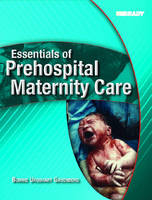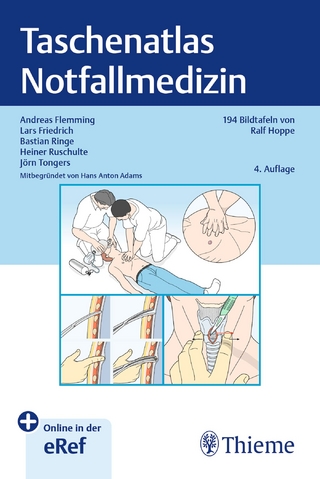
Essentials of Prehospital Maternity Care
Pearson (Verlag)
978-0-13-119990-3 (ISBN)
- Titel ist leider vergriffen;
keine Neuauflage - Artikel merken
The author provides “real life” case studies and review questions to reinforce key points. Helpful professional tips throughout the text prepare providers to facilitate the natural process of birth and stand ready to intervene if complications arise.
Topics covered include:
· Reproductive Anatomy and Physiology
· Evaluating the Pregnant Woman
· Maternal and Fetal Complications
· Threats to Mother and Fetus
· Care of the High-risk Neonate
· Normal Delivery Management
· and much more!
Table of Contents
List of Tables. xxxviii
Acknowledgments. xxxix
Preface. xlii
1. The Woman and the Fetus. 1
Learning Objectives. 1
Key Terms. 1
Case Study. 2
Introduction. 4
Female Internal Reproductive Anatomy and physiology. 5
Ovaries. 5
Fallopian Tubes. 7
Uterus. 8
Vagina. 11
Bony Pelvis. 13
External Reproductive Anatomy. 15
Uterine Abnormalities. 20
Puberty. 23
The Menstrual Cycle. 25
Menopause. 29
Surgical Menopause. 33
Conception and Fetal Development 33
Developmental Highlights from Date of Conception. 41
The Placenta. 48
Fetal Circulation. 49
Congenital Abnormalities. 52
Physical and Behavioral Changes of Pregnancy. 53
Metabolism.. 53
Reproductive System.. 53
Breasts. 55
Nutritional Needs. 55
Cardiovascular System.. 56
Respiratory System.. 57
Urinary System.. 58
Gastrointestinal System.. 58
Musculoskeletal System.. 58
Psychological Changes. 59
Case Study Wrap-Up. 60
Answers. 61
Summary. 62
Review Questions. 63
2. Evaluating the Pregnant Woman. 64
Learning Objectives. 64
Key Terms. 64
Case Study. 65
Introduction. 67
Signs of Pregnancy. 68
Presumptive Signs of Pregnancy. 69
Probable Signs of Pregnancy. 72
Positive Signs of Pregnancy. 73
Taking a Relevant History. 73
Obstetrical History. 75
Evaluating the Present Complaint 79
Universal Precautions. 81
Vital signs. 81
Evaluating the Pregnant Abdomen. 84
Where to transport 94
Incorporating a Patient-Centered Approach. 96
Cultural and Religious Considerations. 97
Antenatal testing. 100
Case Study Wrap-Up. 102
Answers. 102
Summary. 105
Review Questions. 105
3. Pregnancy Complications. 106
Learning Objectives. 106
Key terms. 106
Case Study. 107
Questions. 108
Introduction. 108
Antepartal Bleeding—First half of pregnancy. 109
Spontaneous Abortion. 110
Threatened Abortion. 111
Inevitable Abortion. 113
Complete Abortion. 114
Incomplete Abortion. 114
Missed Abortion. 114
Septic Abortion. 114
Elective Abortion. 115
Therapeutic Abortion. 118
Hydatidiform Mole. 119
Ectopic Pregnancy. 121
Antepartal Bleeding—Second Half of Pregnancy. 125
Placental Abruption. 125
Disseminated Intravascular Coagulation (DIC) 128
Placenta Previa. 129
Pelvic and Abdominal Pain. 131
Ligament Pain. 132
Appendicitis. 133
Urinary Tract Infection. 133
Chorioamnionitis and Pelvic Inflammatory Disease. 136
Cholecystitis/Cholelithiasis. 137
Other Pain. 138
Low Back Pain. 138
Syncope. 139
Hyperemesis Gravidarum.. 140
Hypertensive Disorders. 142
Pregnancy-Induced Hypertension (Preeclampsia) 142
Eclampsia. 145
HELLP Syndrome. 149
Case Study Wrap-Up. 150
Answers. 150
Summary. 152
Review Questions. 153
4. Threats to Mother and Fetus. 154
Learning Objectives. 154
Key terms. 154
Case Study. 155
Questions. 156
Introduction. 156
Trauma in Pregnancy. 157
Vulnerability to Trauma. 158
Consequences of Trauma in Pregnancy. 160
Managing the Trauma Victim.. 161
Cardiac Arrest in Pregnancy. 165
Pregnancy and Chronic Diseases. 168
Asthma. 168
Diabetes. 169
Cardiac Disease. 172
Seizure Disorders. 174
Thromboembolism.. 177
HIV Infection. 178
RH Incompatibilities and Hemolytic Disease. 179
Preterm Labor 180
Carbon Monoxide Poisoning. 185
Substance Abuse. 188
Cocaine and Crack. 188
Opiates. 188
Alcohol 189
Amphetamines. 190
Tobacco. 190
Case Study Wrap-up. 191
Answers. 191
Summary. 192
REVIEW QUESTIONS. 192
5. The Woman in Labor. 194
Learning Objectives. 194
Key terms. 194
Case Study. 195
Questions. 197
Introduction. 197
Mechanism and Stages of Labor 198
Signs of Impending Labor 199
Stages of Labor 202
First-Stage Labor 203
Second-Stage Labor 207
Third-Stage Labor 207
Factors Affecting Length of Labor 208
The “Four P’s”. 208
Maternal Response to Labor 210
Vital Signs. 211
Bladder Function. 212
Gastrointestinal Changes. 212
Fluids and Electrolytes. 213
Induction of Labor 213
Impediments to Labor 214
Comfort Measures. 215
Evaluation of Labor 219
Taking a History and Assessing a Patient in Labor 219
Differentiate between False Labor and True Labor 221
Stay and Deliver or Transport?. 221
Precipitous Delivery. 224
Case Study Wrap-Up. 227
Answers. 227
Summary. 228
REVIEW QUESTIONS. 228
6. Normal Delivery Management 230
Learning Objectives. 230
Key terms. 230
Case Study. 231
QUESTIONS. 231
Introduction. 232
Equipment and Setting. 232
Maternal Positioning. 235
Squatting. 235
Supine (Dorsal, Lithotomy) 235
Semi-Fowler’s Position. 236
Left Lateral Recumbent 237
Hands-and-Knees. 237
Mechanism of Second-Stage Labor (Cardinal Movements) 239
Pushing Techniques. 242
Closed-Glottis Coached Pushing (Valsalva Pushing) 242
Open-Glottis (“Natural”) Pushing. 243
Normal Delivery. 244
Nuchal Cord. 247
Delivering the Body. 249
Immediate Care of the Normal Newborn. 251
Newborn Management Priorities. 252
Cutting the Umbilical Cord. 254
Apgar Scores. 256
Placenta Delivery. 257
Examining Placenta and Membranes. 261
Torn Umbilical Cord. 262
Perineal Tears. 263
Documentation. 267
Case Study Wrap-Up. 268
Answers. 268
SUMMARY.. 269
Review Questions. 270
7. Maternal and Fetal Complications of Labor and Delivery. 271
Learning Objectives. 271
Key Terms. 271
Case Study. 272
Questions. 273
Introduction. 273
Maternal Complications. 273
Third-Stage Hemorrhage. 273
Postpartum Hemorrhage. 275
Retained Placenta. 278
Uterine Rupture. 280
Uterine Prolapse (Uterine Inversion) 282
Amniotic Fluid Embolism.. 283
Chorioamnionitis. 284
Uterine Dysfunction. 285
Fetal Complications. 286
Fetal Heart-Rate Abnormalities. 286
Malpresentations and Cephalopelvic Disproportion. 288
Umbilical Cord Prolapse. 302
Multiple Gestation. 304
Fetal Demise and Stillbirth. 308
Case Study Wrap-Up. 311
Answers. 311
Summary. 312
Review Questions. 313
8. Postpartum Adaptation. 314
Learning Objectives. 314
Key terms. 314
Case Study. 315
Questions. 316
Introduction. 316
Physical Changes. 317
The Uterus after Delivery. 317
The Fundus and Hemostasis. 318
Afterpains. 319
Lochia. 319
Subinvolution. 321
Uterus Displaced by Full Bladder 321
The Vagina and Vulva. 322
Hematoma. 323
Hemorrhoids. 323
Postpartum Infections. 324
Thrombophlebitis. 328
Pulmonary Embolism.. 329
Postpartum Thyroiditis. 330
Emotional Changes. 331
Postpartum Depression. 331
Postpartum Blues. 332
Postpartum Major and Minor Depression. 333
Postpartum Psychosis. 333
Initiating Breastfeeding. 334
SUMMARY.. 337
Case Study Wrap-Up. 338
Answers. 338
Review Questions. 339
9. The Neonate. 340
Learning Objectives. 340
Key Terms. 340
Case Study. 341
Introduction. 342
Care of the Newborn at Delivery. 343
Apgar Scoring. 344
Vital Signs. 345
Physical Assessment of the Newborn. 346
The Skin. 347
The Head. 350
Neck , Trunk, and Genitals. 352
Extremities. 353
Reflexes. 353
Behavior 354
Gestational Age Assessment 354
Postmaturity. 358
Common Illnesses of the Neonate. 360
Hypoglycemia. 360
Hypovolemia. 361
Sepsis. 361
Neonatal Seizures. 363
Jitteriness. 364
Apnea. 364
Hypothermia. 367
Vomiting. 369
Diarrhea. 370
Sudden Infant Death Syndrome. 371
Case Study Wrap-Up. 373
Summary. 374
Review Questions. 374
10. The High-risk Neonate. 376
Learning Objectives. 376
Key Terms. 376
Case Study. 377
Introduction. 378
Care of High-Risk Newborns. 379
The Transition from Fetus to Neonate. 382
Neonatal Resuscitation. 384
Meconium.. 395
Respiratory Distress in the Neonate. 398
Meconium Aspiration Syndrome (MAS) 398
Transient Tachypnea of the Newborn. 399
Persistent Pulmonary Hypertension of the Newborn (Persistent Fetal Circulation) 399
Hypoxic-Ischemic Encephalopathy. 400
Birth Trauma. 401
The Infant with Low Birth Weight 404
Intrauterine Growth Restriction (IUGR) 404
Managing the Premature Infant 405
Conditions Associated with Prematurity. 407
Respiratory Distress Syndrome (RDS or Hyaline Membrane Disease) 407
Bronchopulmonary Dysplasia. 410
Bradycardia. 411
Intraventricular Hemorrhage (IVH) 412
Necrotizing Enterocolitis (NEC) 412
Retinopathy of Prematurity (ROP) 413
Congenital Anomalies. 413
Nervous System.. 414
Cardiovascular 418
Alimentary Tract 423
Genitourinary. 423
Hypospadias and Epispadias. 425
Ambiguous Genitalia. 425
Musculoskeletal/Limbs/Body structure. 428
Abdominal Wall 430
Chromosomal Abnormality. 432
Respiratory. 433
Case Study Wrap-Up. 436
Answers. 436
Summary. 437
Review Questions. 437
11. Gynecology. 439
Learning Objectives. 439
Key terms. 439
Case Study. 440
Questions. 441
Introduction. 441
Abnormal Vaginal Bleeding. 442
Postmenopausal Bleeding. 445
Prehospital Management of Vaginal Bleeding. 445
Acute Pelvic Pain. 447
Ectopic Pregnancy. 448
Pelvic Inflammatory Disease. 449
Other Causes of Noncyclic Pelvic Pain. 450
Cyclic Pain. 453
Nongynecological Pelvic Pain. 456
Prehospital Management of the Woman with Pelvic Pain. 456
Toxic Shock Syndrome. 457
Amenorrhea. 459
Vulvar Itching. 460
Nontraumatic Vulvar pain. 461
Bartholin Abscess. 461
Trauma. 461
Violence against Women. 463
Physical Abuse. 464
The Abuser 464
The Abuser’s Tactics. 465
The Victim.. 466
Seeking Help. 466
Abuse in Pregnancy. 467
The EMS Provider and the Abused Woman. 468
Sexual Abuse. 470
Rape. 471
Transporting the Sexual Assault Victim.. 473
The Evidence. 475
Female Genital Mutilation. 476
Case Study wrap-up. 483
Answers. 483
Summary. 485
Review questions. 485
12. Professional Issues. 487
Learning Objectives. 487
Key terms. 487
Case Study. 488
Questions. 489
Introduction. 489
Documentation. 490
The Pregnant Provider 495
Teratogen Exposure. 495
Disease Exposure. 499
Stress. 503
Physical Activity. 505
Other Concerns. 506
Working with Obstetrical Care Providers. 507
Patient-Centered practice. 515
Earning Trust 515
Excellence in Practice. 518
Holism and Patient-Centered Practice. 520
Case Study Wrap-up. 522
Answers. 522
Summary. 523
Review Questions. 524
Introduction to Appendices. 525
Appendix 1. 526
U.S. FDA Pregnancy-Risk Categories for Drugs. 526
Appendix 2. 528
Drugs Commonly Seen or Administered in Obstetrical and Gynecological Emergencies 528
Appendix 3. 566
Overview of Contraceptive Methods. 566
Glossary. 575
References. 646
About the Author. 659
| Erscheint lt. Verlag | 4.11.2005 |
|---|---|
| Sprache | englisch |
| Maße | 178 x 235 mm |
| Gewicht | 712 g |
| Themenwelt | Medizin / Pharmazie ► Gesundheitsfachberufe ► Rettungsassistent / -sanitäter |
| Medizin / Pharmazie ► Gesundheitswesen | |
| Medizin / Pharmazie ► Pflege | |
| ISBN-10 | 0-13-119990-0 / 0131199900 |
| ISBN-13 | 978-0-13-119990-3 / 9780131199903 |
| Zustand | Neuware |
| Haben Sie eine Frage zum Produkt? |
aus dem Bereich


